python小程序基于Jupyter實現(xiàn)天氣查詢的方法
天氣查詢python小程序第0步:導入工具庫第一步:生成查詢天氣的url鏈接第二步:訪問url鏈接,解析服務器返回的json數(shù)據(jù),變成python的字典數(shù)據(jù)第三步:對字典進行索引,獲取氣溫、風速、風向等天氣信息第四步:遍歷forecast列表中的五個元素,打印天氣信息完整Python代碼本案例是一個非常有趣的python小程序,調(diào)用網(wǎng)絡API查詢指定城市的天氣,并打印輸出天氣信息。
你將學到以下技能:
向網(wǎng)絡API發(fā)起請求,解析和處理服務器返回的json數(shù)據(jù),可以遷移到各種各樣的API中,如PM2.5查詢,道路擁堵查詢,自然災害查詢等。python字典數(shù)據(jù)類型的常用操作以下的代碼運行在jupyter notebook的開發(fā)環(huán)境中,這是python數(shù)據(jù)分析、機器學習、人工智能開發(fā)最常用的開發(fā)界面,因為可以非常方便的撰寫博客、插入圖片和數(shù)學公式,并輸出代碼運行的中間結(jié)果,強烈建議你學習如何使用jupyter notebook。
第0步:導入工具庫
import urllib.requestimport gzip
第一步:生成查詢天氣的url鏈接
city_name = ’上海’# 將城市的中文名字編碼成utf-8字符urllib.parse.quote(city_name)# 將編碼后的城市名拼接在原始鏈接的后面url = ’http://wthrcdn.etouch.cn/weather_mini?city=’ + urllib.parse.quote(city_name)
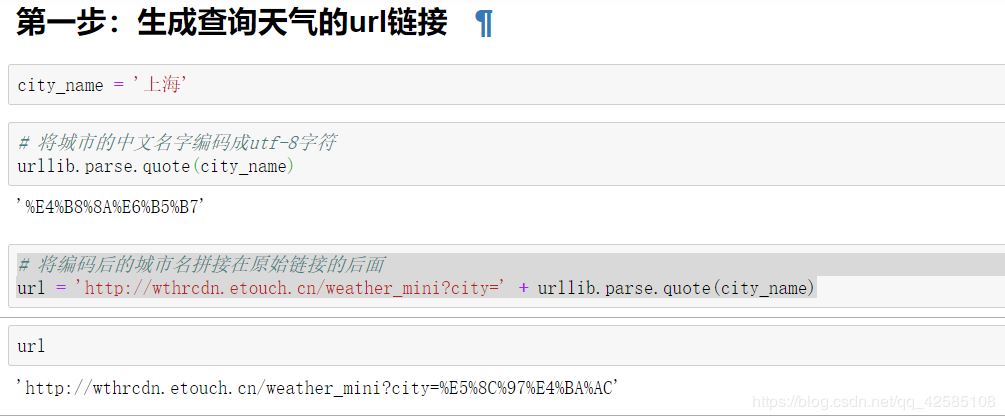
第二步:訪問url鏈接,解析服務器返回的json數(shù)據(jù),變成python的字典數(shù)據(jù)
weather_data = urllib.request.urlopen(url).read()
# 訪問url鏈接,獲取字節(jié)串數(shù)據(jù)weather_data

# 將字節(jié)串解碼為unicode編碼weather_data = gzip.decompress(weather_data)
weather_data
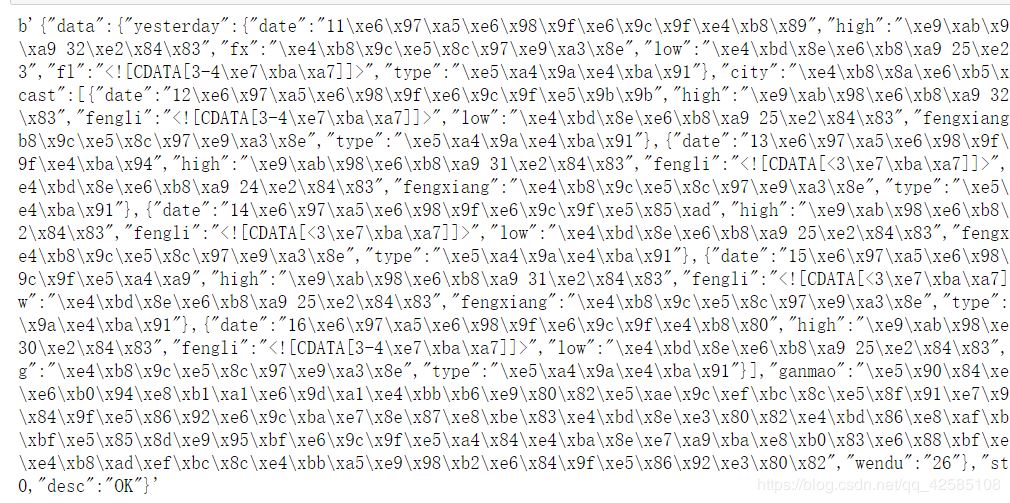
# 將unicode編碼解碼為utf-8編碼,顯示中文weather_data = weather_data.decode(’utf-8’)
weather_data

# 將字符串兩端的引號去掉,變成python中的字典數(shù)據(jù)weather_dict = eval(weather_data)
weather_dict

type(weather_dict)
第三步:對字典進行索引,獲取氣溫、風速、風向等天氣信息
weather_dict
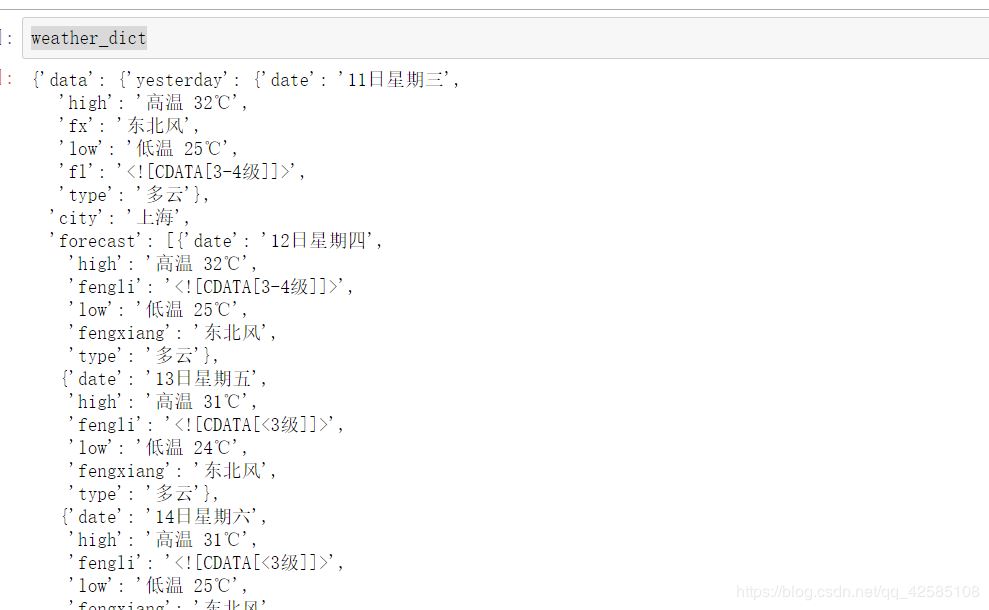
weather_dict[’data’][’yesterday’][’high’]
print(’您查詢的城市:’,weather_dict[’data’][’city’])print(’--------------------------’)print(’今天的天氣’)print(’溫度’,weather_dict[’data’][’wendu’])print(’感冒指數(shù)’,weather_dict[’data’][’ganmao’])print(’--------------------------’)print(’昨天的天氣’)print(’昨天:’,weather_dict[’data’][’yesterday’][’date’])print(’天氣:’,weather_dict[’data’][’yesterday’][’type’])print(’最高氣溫:’,weather_dict[’data’][’yesterday’][’high’])print(’最低氣溫:’,weather_dict[’data’][’yesterday’][’low’])print(’風向:’,weather_dict[’data’][’yesterday’][’fx’])print(’風力:’,weather_dict[’data’][’yesterday’][’fl’][-5:-3])print(’--------------------------’)
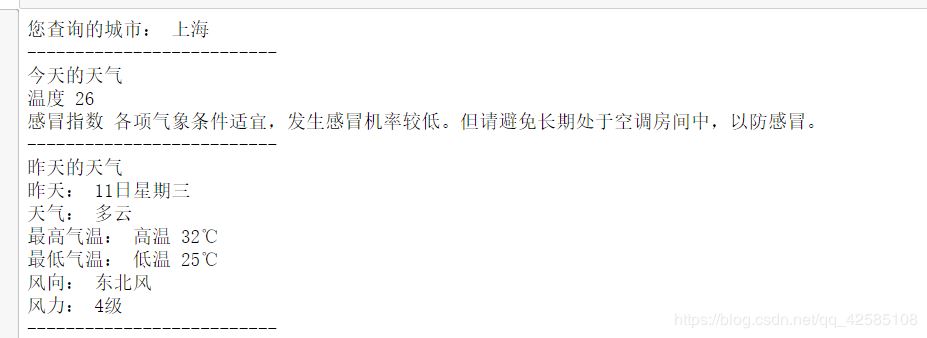
第四步:遍歷forecast列表中的五個元素,打印天氣信息
weather_dict[‘data’][‘forecast’]是一個包含五個元素的列表,每一個元素都是一個字典。
weather_dict[’data’][’forecast’]
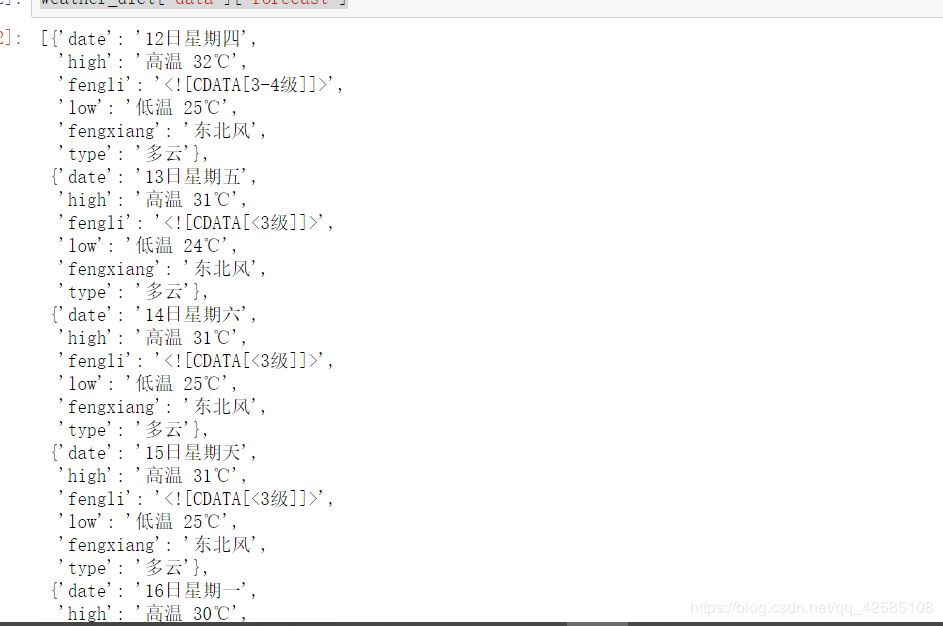
for each in weather_dict[’data’][’forecast’]: print(’日期’,each[’date’]) print(’天氣’,each[’type’]) print(each[’high’]) print(each[’low’]) print(’風向’,each[’fengxiang’]) print(’風力:’,each[’fengli’][-5:-3]) print(’--------------------------’)
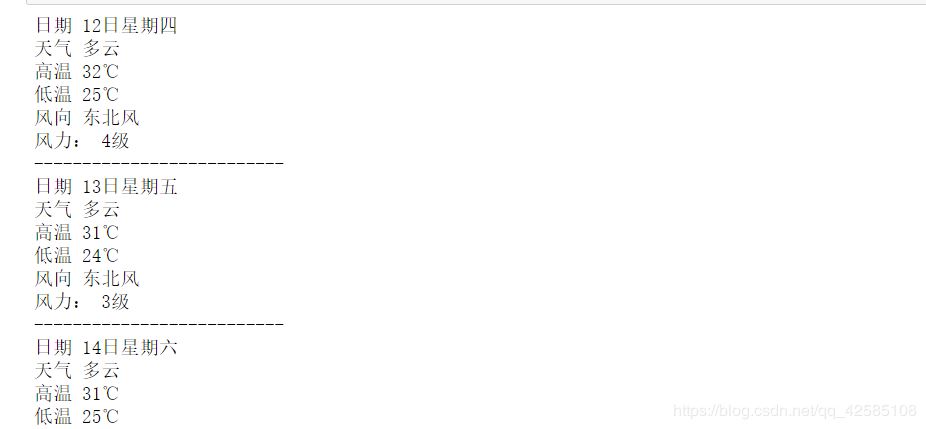
完整Python代碼
# 導入工具庫import urllib.requestimport gzip## 第一步:生成查詢天氣的url鏈接city_name = input(’請輸入要查詢的城市名稱:’)# 將城市的中文名字編碼成utf-8字符urllib.parse.quote(city_name)# 生成完整url鏈接url = ’http://wthrcdn.etouch.cn/weather_mini?city=’+urllib.parse.quote(city_name)## 第二步:訪問url鏈接,解析服務器返回的json數(shù)據(jù),變成python的字典數(shù)據(jù)# 獲取服務器返回的json字節(jié)串數(shù)據(jù)weather_data = urllib.request.urlopen(url).read()# 將字節(jié)串數(shù)據(jù)解碼為unicode中的utf-8數(shù)據(jù)weather_data = gzip.decompress(weather_data).decode(’utf-8’)# 將json數(shù)據(jù)轉(zhuǎn)為python的字典數(shù)據(jù)weather_dict = eval(weather_data)if weather_dict.get(’desc’) == ’invilad-citykey’: print(’您輸入的城市未收錄’) # 第三步:對字典進行索引,獲取氣溫、風速、風向等天氣信息print(’您查詢的城市:’,weather_dict[’data’][’city’])print(’--------------------------’)print(’今天的天氣’)print(’溫度’,weather_dict[’data’][’wendu’])print(’感冒指數(shù)’,weather_dict[’data’][’ganmao’])print(’--------------------------’)print(’昨天的天氣’)print(’昨天:’,weather_dict[’data’][’yesterday’][’date’])print(’天氣:’,weather_dict[’data’][’yesterday’][’type’])print(’最高氣溫:’,weather_dict[’data’][’yesterday’][’high’])print(’最低氣溫:’,weather_dict[’data’][’yesterday’][’low’])print(’風向:’,weather_dict[’data’][’yesterday’][’fx’])print(’風力:’,weather_dict[’data’][’yesterday’][’fl’][-5:-3])print(’--------------------------’)# 第四步:遍歷forecast列表中的五個元素,打印天氣信息for each in weather_dict[’data’][’forecast’]: print(’日期’,each[’date’]) print(’天氣’,each[’type’]) print(each[’high’]) print(each[’low’]) print(’風向’,each[’fengxiang’]) print(’風力:’,each[’fengli’][-5:-3]) print(’--------------------------’)
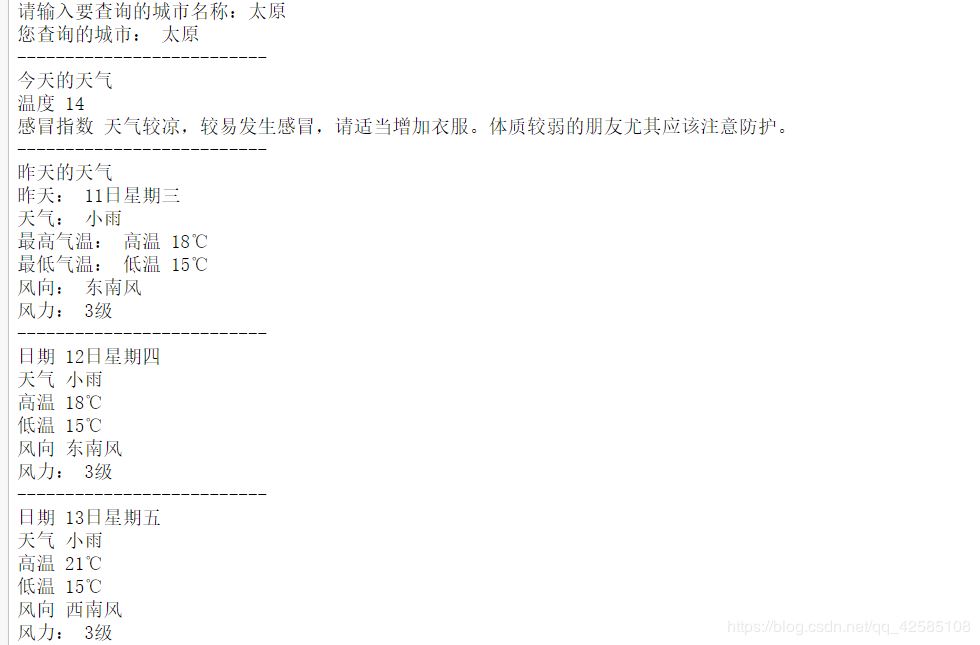
到此這篇關(guān)于python小程序基于Jupyter實現(xiàn)天氣查詢的方法的文章就介紹到這了,更多相關(guān)python Jupyter 天氣查詢內(nèi)容請搜索好吧啦網(wǎng)以前的文章或繼續(xù)瀏覽下面的相關(guān)文章希望大家以后多多支持好吧啦網(wǎng)!
相關(guān)文章:
1. 基于PHP做個圖片防盜鏈2. ASP.NET MVC使用Boostrap實現(xiàn)產(chǎn)品展示、查詢、排序、分頁3. .NET中實現(xiàn)對象數(shù)據(jù)映射示例詳解4. jscript與vbscript 操作XML元素屬性的代碼5. asp.net core 認證和授權(quán)實例詳解6. php使用正則驗證密碼字段的復雜強度原理詳細講解 原創(chuàng)7. XML在語音合成中的應用8. 如何使用ASP.NET Core 配置文件9. 基于javaweb+jsp實現(xiàn)企業(yè)車輛管理系統(tǒng)10. ASP.NET MVC把數(shù)據(jù)庫中枚舉項的數(shù)字轉(zhuǎn)換成文字

 網(wǎng)公網(wǎng)安備
網(wǎng)公網(wǎng)安備